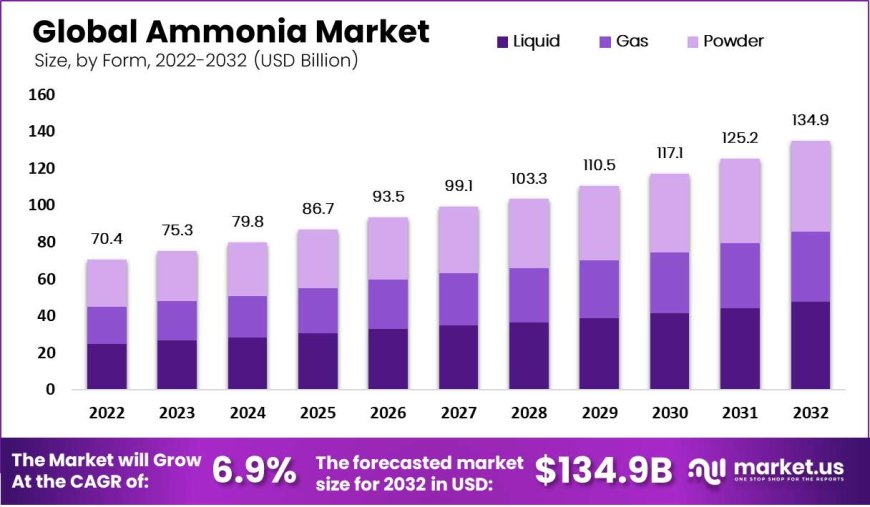Emerging Applications of Ammonia Set to Transform Industrial Sectors
Ammonia Market By Form (Gas, Liquid, and Powder), By Application (Fertilizers, Textiles, Pharmaceuticals, Refrigerants, and Other Applications), By Region and Companies - Industry Segment Outlook, Market Assessment, Competition Scenario, Trends, and Forecast 2023-2032
Ammonia Market size was valued at USD 70.4 Billion. This market is estimated to reach USD 134.9 Billion in 2032 the highest CAGR of 6.9% between 2023 and 2032. Ammonia, a colorless gas that emits a distinctive odor, is also known as a building block chemical.
The ammonia market refers to the global industry involved in the production, distribution, and utilization of ammonia across various sectors. Ammonia is a vital chemical compound extensively used in agriculture as a key component of ammonium-nitrate fertilizers, which are essential for providing nitrogen, a crucial nutrient for plant growth. The use of ammonia-based fertilizers is fundamental in maintaining soil productivity and ensuring healthy crop yields, addressing the growing global demand for food.
Beyond its agricultural applications, ammonia is a versatile compound with significant industrial uses. It serves as a popular refrigerant gas in air-conditioning systems due to its ability to absorb large amounts of heat, making it valuable in the food and beverage industry for cold storage and processing.
Additionally, ammonia is utilized in water purification, waste treatment, and the manufacturing of various products such as plastics, explosives, textiles, pesticides, and household cleaning agents. Its widespread applications across multiple industries underscore the growing demand for ammonia, propelling the market's growth during the forecast period.
Get a Sample Copy with Graphs & List of Figures @ https://market.us/report/ammonia-market/request-sample/
Key Market Segments
By Form
-
Gas
-
Liquid
-
Powder
By Application
-
Fertilizers
-
Textiles
-
Pharmaceutical
-
Others
Form Analysis: The liquid form of ammonia dominates the market, driven by its widespread use in fertilizers, industrial applications, and household cleaning. Anhydrous ammonia, a highly pure and concentrated form, is primarily utilized as a fertilizer due to its efficient nitrogen content.
Application Analysis: Fertilizers lead the global ammonia market, as ammonia is crucial for producing ammonium-nitrate fertilizers that provide essential nutrients for plant growth. Rising population and food demand, along with advanced farming techniques, further drive ammonia market growth.
Key Players
-
Yara International ASA
-
BASF SE
-
CF Industries Holdings, Inc.
-
Nutrien Ltd.
-
SABIC
-
Qatar Petroleum
-
EuroChem Group
-
Koch Fertilizer, LLC
-
Praxair Technology, Inc.
-
China National Petroleum Corporation
-
Rashtriya Chemicals and Fertilizers Limited (RCFL)
-
Other Key Players
Drivers:
The growing global population and rising food demand necessitate increased agricultural production, thereby boosting ammonia consumption. Technological advancements have also expanded ammonia's applications, including its emerging role as a green marine fuel, which emits no carbon and complies with environmental regulations. Government subsidies for fertilizers further amplify ammonia demand.
Restraints:
Direct contact with concentrated ammonia poses significant health risks, causing severe burns, eye damage, and respiratory issues. These health hazards can hinder market growth. Additionally, regions like North America that rely on ammonia imports face challenges such as price volatility and supply shortages. The environmental impact of chemical fertilizers also drives a shift towards sustainable agricultural practices, potentially reducing ammonia demand.
Opportunities:
The development of green ammonia presents significant growth opportunities. Green ammonia, with its low emissions, is gaining traction as an alternative marine fuel and in power generation. Investments in green ammonia infrastructure and research into its diverse applications are set to expand its market. The shift towards sustainable agricultural practices also opens avenues for eco-friendly ammonia-based products.
Challenges:
Ensuring the safe handling and use of ammonia to mitigate health risks is a major challenge. Additionally, the volatility in ammonia prices and the dependence on imports in certain regions pose supply chain challenges. Balancing the environmental impact of ammonia-based fertilizers with the need for high agricultural productivity also remains a critical issue for the industry.













